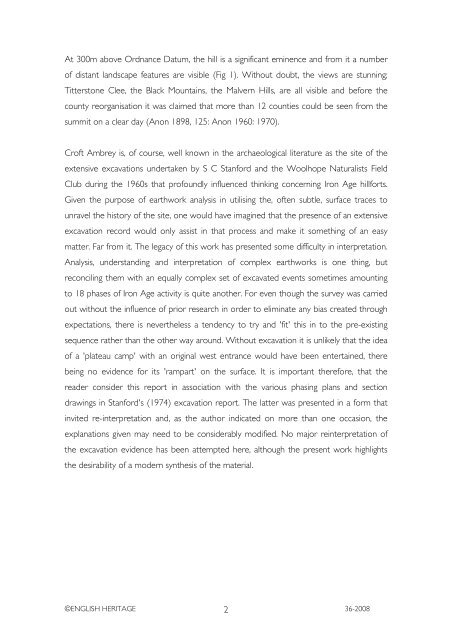CROFT AMBREY, AYMESTREY ... - English Heritage
CROFT AMBREY, AYMESTREY ... - English Heritage
CROFT AMBREY, AYMESTREY ... - English Heritage
You also want an ePaper? Increase the reach of your titles
YUMPU automatically turns print PDFs into web optimized ePapers that Google loves.
At 300m above Ordnance Datum, the hill is a significant eminence and from it a number<br />
of distant landscape features are visible (Fig 1). Without doubt, the views are stunning;<br />
Titterstone Clee, the Black Mountains, the Malvern Hills, are all visible and before the<br />
county reorganisation it was claimed that more than 12 counties could be seen from the<br />
summit on a clear day (Anon 1898, 125: Anon 1960: 1970).<br />
Croft Ambrey is, of course, well known in the archaeological literature as the site of the<br />
extensive excavations undertaken by S C Stanford and the Woolhope Naturalists Field<br />
Club during the 1960s that profoundly influenced thinking concerning Iron Age hillforts.<br />
Given the purpose of earthwork analysis in utilising the, often subtle, surface traces to<br />
unravel the history of the site, one would have imagined that the presence of an extensive<br />
excavation record would only assist in that process and make it something of an easy<br />
matter. Far from it. The legacy of this work has presented some difficulty in interpretation.<br />
Analysis, understanding and interpretation of complex earthworks is one thing, but<br />
reconciling them with an equally complex set of excavated events sometimes amounting<br />
to 18 phases of Iron Age activity is quite another. For even though the survey was carried<br />
out without the influence of prior research in order to eliminate any bias created through<br />
expectations, there is nevertheless a tendency to try and 'fit' this in to the pre-existing<br />
sequence rather than the other way around. Without excavation it is unlikely that the idea<br />
of a 'plateau camp' with an original west entrance would have been entertained, there<br />
being no evidence for its 'rampart' on the surface. It is important therefore, that the<br />
reader consider this report in association with the various phasing plans and section<br />
drawings in Stanford's (1974) excavation report. The latter was presented in a form that<br />
invited re-interpretation and, as the author indicated on more than one occasion, the<br />
explanations given may need to be considerably modified. No major reinterpretation of<br />
the excavation evidence has been attempted here, although the present work highlights<br />
the desirability of a modern synthesis of the material.<br />
©ENGLISH HERITAGE 2<br />
36-2008

















